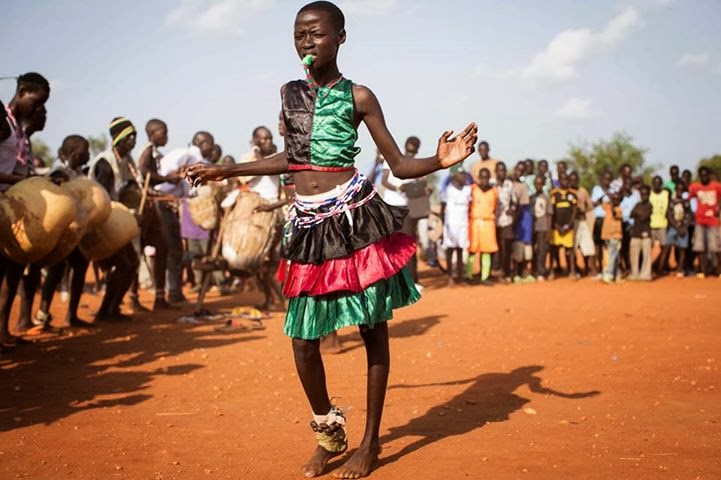
Besides those in Uganda, this group of people are found in Southern Sudan, north- eastern Zaire, and the Central African Republic. In Uganda it includes the Lugbara, the Madi, the M etu, the Okebu and the Lendu. They all trace their origin from southern Sudan but their customs and cultures differ significantly.
THE LUGBARA
The Lugbara constitute the largest Ethnic group in eastt Africa.
Origins.
The Lugbara are a Sudanic speaking peopleand their language is one of the eastern Sudanic languages of the Madi, the Lugbara, the Kericho, the Lo g, and the Avukaya. They are believed to have come form Sudan at a place called Rajaf in Juba region or Baar in Bari. Recent research has revealed that the Lugbara originally occupied Loloyi and Baar region.
They were originally known as the Madi and the term Lugbara perhaps came to be used after the intrusion of the Khartoum Arab slaves in the second half of the 19th century. Most Lugbara traditions regarding their origins begin with God’s creation of Meme the universe. The first two human beings Gboro-Gboro (male) and (female) are said to have been superhuman. Some traditions only speak of Meme whose womb God filled with the living things in the world. Then a gazelle made an opening in Meme’s womb by rupturing it with its hoof and all the worldly creatures came out; man was the last to come out.
The first human beings are said to have been twins: Arube and O’duu. Arube was a boy while O’duu was a girl. These twins unlike their parents Gboro-Gboro and Meme, wee believed to have been ordinary human being and tradition asserts that they were born in the ordinary way. Meme died immediately after giving birth to the twins.
It is said that when these children grew up, they married each other and produced children who through generations multiplied t produce the Jokodra, Lebenyere, Mutalema and Telebyere clans. However, most of the northwestern Lugbara claim that they were the descendants of Jaki whose sons disappeared from Mt. Liru in the Sudan towards the beginning of the 18th century. The Rubu group claim descent form Aroba who is also said to have migrated from Mt. Liru to found the Otrabu-Rubu and Rubu- yia clans. It can be deduced form these traditions that the Lugbara might have been a fusion of the Madi and Bari.
Social institutions
The highest social political organization among the Lugbara was the clan. The clan was normally headed by a clan leader called Opi. All members of the same clan claimed descent form a common ancestor to whom they were paternally related. All the elders of the clan exercised influence over political and social affairs and they had powers to curse and punish any of their subordinates. Every married man had authority over his wives and children and even after his sons had married, he still had power over them and their children. The Lugbara had a clientage system called Amadingo whereby the poor or the destitute were treated as embers of the family and they could be given land if they wished to stay. Bridewealth would even be paid fort hem by their hosts if they wished to marry during their clientage.
Birth
Whenever a child was born, the first thing to be done was a ritual of cutting off the umbilical cord. If the baby was a boy, the acting midwife was required to cut the cord in four strokes. If the baby was a girl, the cord was cut in three strokes. In traditional Lugbara, the numbers four and three symbolize men and women respectively.
After giving birth, the mother would stay in confinement for three to four days depending on the sex of the child. Besides she was abstained form eating certain foods and could receive a few visitors because some might have evil intentions and might do harm to the health of the child or even cause its death. The ritual of confinement was followed by festivities that ended with the naming of the child. The name given portrayed some memorable experience when the child was still unborn. For example, if the child was born during famine, it would be named Abiriga.
Initiation
During puberty, both girls and boys underwent two important rituals of tribal identification. These were face tattooing and extraction of six frontal teeth form the lower jaw. This was intended both as a way of decoration and as an initiation into adulthood. These two experiences were said to be very painful albeit compulsory. Anybody who was over due these operations would still be called a child. No one would aspire to marry unless he or she had gone through this initiation.
Marriage
In the very distant past, at a time when tribal warfare characterized Lugbara society, courtship is also said to have been impossible. In those days, parents used to arrange marriages for their children. Marriage reservations could be made by the parents even when the children were of tender age.
When war fare subsided considerably, courtship became possible. The boy’s father would transfer bride wealth to the girl’s home and thereafter, the couple was customarily married. Divorce was rare indeed. It could only occur if the woman failed to have children or if she was found in possession of poisonous charms or any other substance that could be used to kill people.
Burial
The burial of a chief differed considerably from that of ordinary men. After the announcement of a chief’s death, no one was allowed to wail because it was feared that if one wailed, before burial, the corpse might turn into a lion or a leopard and attack people. Therefore prior to the chief’s burial, mourners would weep quietly.
A bull was slaughtered for the mourners and its hide was used to wrap the corpse. The burial was in the middle of the night and the body was placed in the grave facing northwards towards Mt. Liru where the Lugbara believe they originated. After burial, a sorrowful song would be sung and the mourners would wail as they danced. A barkcloth tree (laru) would be planted on the grave. Food could be served during part of the mourning. The paternal relatives of the late Opi (chief) cold give avuti (death duty in the form of a bull) to the chief’s maternal relatives.
The burial procedure for ordinary people was similar to that for a chief except that in the event of death of an ordinary person, mourners were allowed to mourn immediately after death without any fear that the corpse might turn into a lion or leopard. Besides, the Laru was a not usually planted on the grave. At all burials, the adi (traditional history) of the deceased was recounted and funeral dances were compulsory.
Avuti
Customarily, an individual was affectionately treated by his mother’s relatives who referred to him as ama ezaapi (our (daughter). He or she referred to them as adropika (my uncles). It was a custom that upon an individual’s death the maternal clan demanded a death duty in the form of a bull called avuti (the corpse bull). It would often generate a mock or real fight in this demand was not granted.
Political set-up
The political set-up of the Lugbara was segementary. The most important figure was a chief known as Ozoo-Opi. He sometimes had both political and rainmaking powers. But in so me cases, the Ozoo-Opi did not possess rain making powers. In such an event, another individual was entrusted with the powers of rainmaking. Such an individual was called Ozoo-ei. The Ozoo-Opi was the chief custodian of the clan’s property. In any case, harvesting could not be done without the blessing of the Opi. It was his duty to offer new harvests t the gods and he had to taste the produce before the producers could taste them.
In the event of the clan ceremonial feast, he officially opened it by starting to eat before anybody else. He was given the most delicious meat which always included a piece of liver. The Opi rarely offered sacrifices to the ancestors although their power to lead was believed to be derived form the ancestors. They had, however, the duty of offering sacrifices to the god of the clan.
Custom demanded that an Opi should be able to recount the adi (testimonies) during funeral rites, serious illness and major social gatherings like marriage ceremonies. The prospective Opi learnt adi by observation. The actual practice of recounting the adi was solemn. The Opi would stand up and narrate the history of the clan to stress the oneness. The he would proceed to recount the background of the occasion for which the adi was being recounted. He would symbolically move forward and backwards while shooting an arrow upwards at each stop. Of he happened to forget appoint, or got mixed up during the process, it was normal and acceptable for another elder to correct him. Usually the adi would be followed by the settlement of the issue ant hand.
Succession of an Opi
Among the Lugbara, succession of an Opi was a peaceful affair. The date of the succession was a very honorable occasion and it was attended by all the notables of the clan. This occasion was punctuated by a lot of beer and food. Amidst all this, the most senior Opi within the lineage presented the new Opi with an anderiku (a chiefly stool which was sometimes simply referred to as Opi Angua). After the new Opi had sat on the stool, he was presented with the rest of the chiefly regalia namely; a spear, a bow and arrows and a bracelet. Then a congregation of lineage chiefs would formerly brief the new Opi on the qualities and rules of conduct which would be expected of him as a leader and alert him of the heavy responsibility he would have to shoulder.
Judicial system
Any affairs which affected the clan would be handled by the lineage and clan heads. Normally, minor offences would be settled by the lineage heads but serious ones required clan heads. Examples of such serious cases included killing a relative, adultery, unpaid loans and the more serious forms of wizardly, witch craft and sorcery. The lineage court comprised of all family heads and it was presided over by the lineage head. The clan court was a higher court comprising of all the lineage heads who often co-opted other notables and some wealth men if they deemed it appropriate.
Court proceedings usually took place under a big tree in the compound and trials were conducted in privacy. As a matter of fact, women and children were not allowed to linger around the area unless they were called upon as witnesses. In an intra-clan affair, a murderer was fined a bull for the murder if a man and a cow for the murder of a woman. In cases of adultery, it was fashionable to give a bull to the affected husband. Incest was also abhorred and in case it took place, the male relative of the girl was fined a sheep which was slaughtered and eaten by the family to cleanse the sin.
Inter-clan cases were more serious than intra-clan ones. An intra-clan adultery case for instance, was serious enough to require a capital punishment. If caught red- handed, the man would be killed or if he was lucky enough he would have his sexual organs maimed. In cases of fornication, the boy would be held as ransom until he agreed to marry the girl or paid an appropriate fine. Failure to comply would also lead to the maiming of his sexual organs. Unsettled loans would also lead to war between the clans.
Economy
The Lugbara were agriculturalists. They claim in heir tradition that they had once owned a lot of cattle which were decimated by rinderpest. During the period of their early migration, they brought wit them simple possessions such as sheep, goats, millet and sorghum. They also got food by hunting buffaloes, bushbuck, antelopes, rabbits, squirrels and several other animals. In addition, they also carried out fishing and trapped a variety of birds. Both indigenous and migratory grasshoppers were caught and eaten. The roots and fruits of some wild plants were also gathered.
Property ownership
The land among the Lugbara was categorized into virgin land, fallow and land under cultivation. All land within a clan was communally owned and at least theoretically individuals could lay claim to any part of the virgin land. The same applied to the fallow land but in this case, the consent of the former owner was sought before carrying out any cultivation on it.
Cattle
Cattle served the needs of the family which owned them. However, theoretically, they were said to belong to the whole clan and Opi in particular as the chief custodian. The wealthy people Barukuza had a lot of food, cattle and many wives. For this reason, they wielded much power and influence next to the Opi.
A married woman could not claim independent ownership of property. This was because she was customarily reared as the husband’s property and all that she had was as a matter of course his possession. A woman could only control food. Here she was free and she could even deliberately starve her husband and he would not put up a fight.
Children like women were not allowed independent ownership of property. The only exception in this case was a boy of marriageable age. If his father died, he would automatically claim his father’s property as there would be no need for it to be taken care of by the lineage or clan heads or Opi.
Handcraft
Women produced various articles of handcraft including various types of baskets and pots. The most common were ivua (food basket), kuta (food cover), kubi (sauce pot), and ajiko (sauce fir preparing millet flour). The Lugbara also did some iron smelting and the ondoo (clever ones) made iron implements for the rest of the population. There was also among the Lugbara another ethnic group known as Okebu who specialized in Iron smelting.

 Posted in
Posted in 

